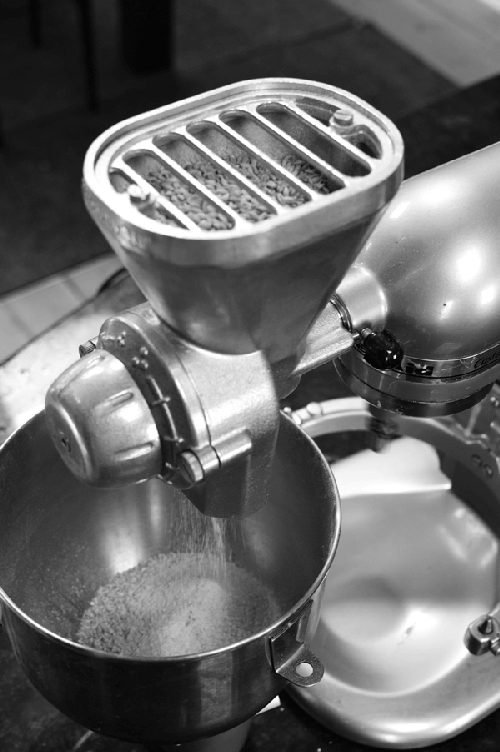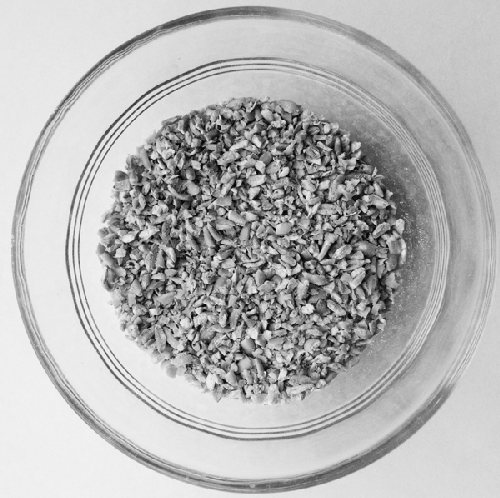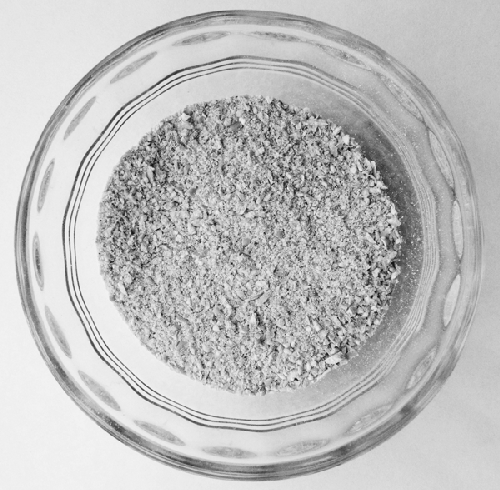|
Weight
|
Volume
|
Baker’s %
|
Ingredient
|
|---|
|
390g
|
3 to 3¼ cups
|
100%
|
All-purpose white flour
|
|
300g
|
1¼ cups
|
77%
|
Water
|
|
7g
|
1 teaspoon
|
1.8%
|
Salt
|
|
~2g
|
½ teaspoon
|
–
|
Fresh yeast (a pea-sized lump); you can substitute 1 teaspoon (5g) instant
yeast
|
Mix everything until the flour is completely moistened. This should take only about 30
seconds. Cover and let rest at room temperature for 20 hours.

Place a medium-sized cast iron pot in your oven and preheat both to 450°F / 230°C.
While the oven is heating, transfer the dough onto a floured surface and fold three or
four times. Leave for 15 minutes. Shape rapidly into a boule—a round loaf—and place on a
generously floured cloth towel. Proof until doubled in size. Dump into the preheated cast
iron pot and bake with the lid on for 30 minutes. Take the lid off and bake until the
crust has a dark golden color, about 15 minutes.
Milling flour is a lot easier than you
might imagine: snag some wheat berries—which are just hulled wheat kernels, with bran,
germ, and endosperm still intact—from your local health food store or co-op, run them
through a mill, and you’ve got fresh flour.

Why bother? Well, for one, the taste is fresher; volatile compounds in the wheat won’t
have had time to break down. Then there are the health aspects. Most commercial whole
wheat flours have to heat-process the germ to prevent it from going rancid, but this
heat-processing also affects some of the fats in the flour.
On the downside, freshly milled flour won’t develop gluten as well as aged flour. For
a rustic loaf of bread, this is probably fine, but it’s not so good if you’re trying to
make whole wheat pasta, in which the gluten helps hold the pasta together. Of course, you
can always add in some gluten flour to boost the gluten levels back up.
You have a couple of options for mills. KitchenAid makes a mill attachment for its
mixers. If you do spring for a KitchenAid attachment, though, be warned that it can put
quite a strain on the mixer. Set it to low speed and run your grain through in two passes,
doing a first pass to a coarse grind before doing a fine grind. Alternatively, take a look
at K-Tec’s Kitchen Mill, which is in roughly the same price range but is designed
specifically for the task.
You can run other grains, such as rice and barley, through a mill as well. Too-moist
grains and higher-fat items such as almonds or cocoa nibs are a no-go, though: they’ll gum
up the grinder.
Wheat berries.

First pass: coarse grind.

Second pass: fine grind.

P.S. Don’t expect to be able to mill things like cake flour. Cake flour is bleached
with chlorine gas to mature it. Maturing—the process by which flour
is aged—would eventually happen naturally due to oxidation, but chlorine treatment speeds
it up. It also modifies the starch in the flour so that it can absorb more water during
gelatinization and weakens
the proteins in the flour, reducing the amount of gluten that can be formed. Additionally,
chlorination lowers the temperature of gelatinization, so batters that include
solids—nuts, fruits, chocolate chips—perform better because there’s less time for the
solids to sink before the starches are able to gel up around them.